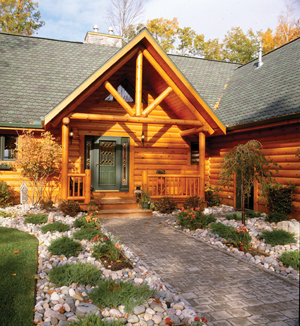Since the economic downturn of 2008 has persisted for more than three years, the log home lending landscape has been altered in numerous ways. Or has it? The days of easy money, 100 percent financing, and repayment terms that could best be described as liberal are essentially over. Although for many those were considered the good times, current market conditions signal, more than anything else, a return to the basic principles of purchasing real estate.
Qualified purchasers can still realize the dream of owning the log home they have wanted for some time. However, the financing aspect of the equation now involves a return to the fundamentals of borrowing. Buyers must demonstrate the capacity to repay the mortgage they seek. In most cases, at least 20 percent cash equity or equity in the building lot in the case of construction is required. Strong credit scores are a must. Verification of income through pay stubs, W-2s, or tax returns in the case of self-employed borrowers is standard. In short, log home buyers should take the time to become informed, to prepare for the application and loan closing process, and to expect an experience that is somewhat more arduous than it was a few years ago but no less satisfying when the deal closes.
“Loan parameters are generally more conservative,” explained Troy Kennedy, National Log and Timber Team Leader for Wells Fargo Home Mortgage, “but it depends on each borrower’s unique situation. While some requirements such as credit score haven’t changed very much, others such as down payment have. We can still offer conventional conforming loans up to $417,000 with a 680 credit score and conventional non-conforming ‘jumbo’ loans with a 720 credit score. The biggest change is the loan to value ratio. We used to be able to provide 100 percent financing, and now we are at 75 percent.”
While it may appear to some potential log home purchasers that the opportunities for financing have disappeared in recent months, professionals are quick to point out that money is available. Considering that demand for log homes has slackened along with the general slowdown in the real estate markets, potential bargains are on the market as well.

Hiawatha Log Homes
“The money is out there, but you need money in the deal,” noted Greg Ebersole, a loan officer with Graystone Mortgage, a division of Graystone Tower Bank. “I would say that lending parameters are no more restrictive here than they were four or five years ago. We never had those no-money-down and interest-only programs that were really reaching out there and getting people in over their heads with more log home than they could really afford. Without a doubt this is a good time to look for a log home if a person can qualify financially. Home prices are down, and interest rates are at all-time lows. Builders are hungry for business, so pricing is more aggressive. There may never be a better time.”
Of course, the opportunities are there for those who qualify. Evaluating the need for equity in a log home purchase is a simple exercise. A sale price of $400,000 with a 20 percent down payment requires a cash injection of $80,000. Buyers must also make allowances to pay closing costs, which may often range from one to three percent of the loan amount. Therefore, the total cash to close such a purchase will likely range from $84,000 to $92,000.
“I would say the key is in the preparation,” commented Andy West, vice president of West & Gasparini Group Wealth Management Advisors for Merrill Lynch and an advisor to the log and timber frame industry. “If you have to borrow every nickel needed, then just keep saving. It is a fair statement that lending regulations are strictly enforced now, and a number of the institutions where we used to place certain log home purchasers for financing are no longer around.
“Potential log home buyers need to look at how much money they make, how much money they have, how much they want to spend, and how long they want to owe the debt for their purchase,” continued West. “I try to get people set on a course to say that if their log home purchase is not going to happen today there are steps that can be taken to get there. They need to develop a plan of attack so they can go forward and pretty up their personal balance sheet.”
Those who are moving ahead with log home purchases can help themselves in the financing journey by providing requested information at the time of application. In addition to a completed application form, income verification statements or tax returns, and bank statements to verify funds on hand for the necessary equity injection, borrowers should be prepared to provide detailed information on assets and liabilities, including account numbers and balances owed to creditors. The more information available, the faster the process moves along.
Log homes have not been immune from the declining values of all types of real estate in recent years. Therefore, purchasers should take time to determine the price range that is appropriate for them with respect to current market values. Assessing recent sales data from targeted communities will provide buyers with perspective on pricing and diminish the potential for situations in which appraisals are significantly below the expected values. In such cases, borrowers may be required to put more cash down or renegotiate the price of the subject property with the seller.
Although the log home purchase ambitions of some potential buyers may have endured a setback with recent economic conditions, others are positioned to take advantage of today’s circumstances. With favorable prices and interest rates along with a wide selection of log homes from which to choose, the current market favors the buyer. One of the most critical steps in the purchase process is the selection of mortgage and professionals who can advise and support the effort from beginning to successful completion.

